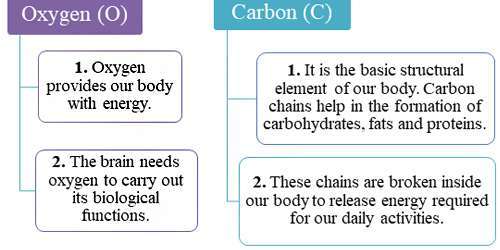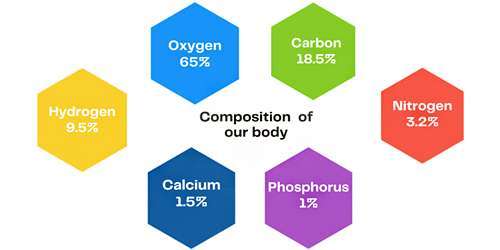Elements in the Human Body
In this concept the students will learn about the elements in the human body. Here, the students will be introduced to varieties of elements that control the body systems and functions.
After reading the concept, students will be able to:
- Know the importance of different gaseous elements inside the human body.
- State the function of oxygen, hydrogen, and function of nitrogen.
- Mention the percentage of carbon in human body.
- Understand what is calcification.
- Explain the importance of water in human body, and how to control dehydration..
Each concept is explained to class 4 students using descriptions, illustrations, and concept maps. After you go through a concept, assess your learning by solving the two printable worksheets given at the end of the page.
Download the worksheets and check your answers with the worksheet solutions for the concept of Elements in the human Body provided in PDF format.
The human body consists of six main elements, namely—
(i) Oxygen (ii) Carbon (iii) Hydrogen
(iv) Nitrogen (v) Calcium (vi) Phosphorus
Apart from these, elements like potassium, sodium, chlorine, magnesium, and sulphur are also present in tiny quantities in the body.

All of the above-mentioned elements are extremely vital for the proper functioning of our bodies. Let us have a detailed look at the elements—
| Name of the element | Quantity (in percentage) | Name of the element | Quantity (in percentage) |
| (i) Oxygen | 65% | (vii) Potassium | 0.4% |
| (ii) Carbon | 18.5% | (viii) Sulphur | 0.3% |
| (iii) Hydrogen | 9.5% | (ix) Sodium | 0.2% |
| (iv) Nitrogen | 3.3% | (x) Chlorine | 0.2% |
| (v) Calcium | 1.5% | (xi) Magnesium | 0.1% |
| (vi) Phosphorus | 1% |
Functions of the Main Elements:



New Words
Calcification-A process in which calcium builds up in the body tissues and helps in the formation of bones.
Synthesis-Formation of a substance by the combination of different things.
Did You Know?
Milk, yogurt and cheese are foods rich in calcium, and should be included in our diet.

Not drinking sufficient amount of water may lead to dehydration, weakness, dry skin and digestion-related disorders.


CBSE Schools In Popular Cities
- CBSE Schools in Bangalore
- CBSE Schools in Mumbai
- CBSE Schools in Pune
- CBSE Schools in Hyderabad
- CBSE Schools in Chennai
- CBSE Schools in Gurgaon
- CBSE Schools in Kolkata
- CBSE Schools in Indore
- CBSE Schools in Sonipat
- CBSE Schools in Delhi
- CBSE Schools in Rohtak
- CBSE Schools in Bhopal
- CBSE Schools in Aurangabad
- CBSE Schools in Jabalpur
- CBSE Schools in Jaipur
- CBSE Schools in Jodhpur
- CBSE Schools in Nagpur
- CBSE Schools in Ahmednagar
- CBSE School In Tumkur











